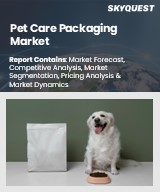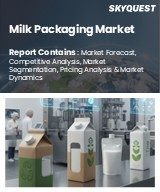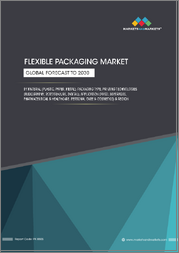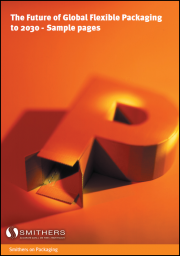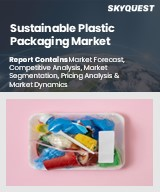
|
시장보고서
상품코드
1725104
세계의 모듈식 포장기기 시장 예측 : 유형별, 자동화 레벨별, 유통 채널별, 최종 사용자별, 지역별 분석, 예측(-2032년)Modular Packaging Equipment Market Forecasts to 2032 - Global Analysis By Type (Primary Packaging Equipment, Secondary Packaging Equipment, and Other Types), Automation Level, Distribution Channel, End User and By Geography |
||||||
Stratistics MRC에 따르면, 모듈형 포장 장비 세계 시장은 2025년에 163억 1,000만 달러, 예측 기간 동안 CAGR 7.2%로, 2032년에는 265억 4,000만 달러에 이를 전망입니다.
모듈식 포장기기는 교체 가능하고 맞춤형 모듈로 구성된 패키징 프로세스를 위해 설계된 유연하고 확장 가능한 시스템을 말합니다. 이러한 기계는 특정 생산 요구에 맞게 쉽게 구성하거나 확장할 수 있어 다양한 산업에서 효율성과 적응성을 제공합니다. 모듈식 시스템은 전체 설치를 교체하지 않고도 신속한 재구성 및 업그레이드를 가능하게 함으로써 충전, 밀봉, 라벨링, 포장 등의 작업을 간소화합니다. 이 접근법은 가동 중지 시간을 줄이고 생산성을 향상시키고 변화하는 제품 수요 및 포장 요구 사항을 충족하는 비용 효율적인 확장을 지원합니다.
인도 국가투자진흥원에 따르면 인도의 가공식품산업은 2020년 말까지 약 5,430억 달러에 달했으며, 식품포장기기 시장에서 사업 전개하는 기업에 충분한 기회를 제공했습니다.
맞춤형 포장 솔루션에 대한 수요 증가
기업은 변화하는 고객의 요구를 충족시키기 위해 보다 유연하고 확장 가능한 패키징 옵션을 요구하고 있습니다. 포장 디자인의 혁신은 미적 감각, 기능성, 지속 가능성을 향상시켜 시장 확장을 더욱 촉진합니다. 또한 전자상거래의 성장으로 제품의 보호와 사용자 체험을 높이는 특수한 패키징이 필요해지고 있습니다.
기술적 복잡성과 유지보수의 필요성
모듈식 포장기기를 효과적으로 조작하고 문제를 해결하려면 숙련된 인력이 필요합니다. 잦은 유지보수와 비용이 많이 드는 수리는 광범위한 채택을 방해할 수 있습니다. 제조업체는 이러한 기계와 관련된 기술적 장애물을 해결하기 위해 교육 프로그램에 투자해야합니다.
Industry 4.0과 스마트 매뉴팩처링 채택
인더스트리 4.0 기술은 예지보전을 가능하게 하고, 조업의 중단을 줄이고, 효율을 극대화합니다. 엔지니어링 공정의 유연성과 정확성 향상 디지털화로의 전환은 제조업체의 합리화된 운영과 비용 절감을 보장합니다.
시스템 운영을 위한 숙련 노동자 부족
훈련된 전문가가 제한되어 있다면 시장에 큰 위협이 됩니다. 자동차는 전문 지식의 격차를 채우기 위해 노동력 교육 프로그램에 투자해야합니다.
COVID-19의 영향
COVID-19의 주요 유행은 모듈식 포장기기 시장에 다양한 영향을 미쳤습니다. 그 후 기업은 첨단 패키징 기술을 통한 효율성 최적화에 계속 주력하고 있습니다.
예측 기간 동안 반자동 시스템 분야가 최대화될 전망
반자동 시스템 부문은 효율성과 합리적인 가격의 균형으로 예측 기간 동안 최대 시장 점유율을 차지할 것으로 예측됩니다. 기업은 대규모 자동화 투자 없이 생산을 합리화하기 위해 반자동 패키징 장비를 선호합니다.
화장품 및 퍼스널케어 분야가 예측 기간 중 가장 높은 CAGR이 전망된다.
예측기간 중 화장품 및 퍼스널케어 분야가 가장 높은 성장률을 보일 것으로 예측됩니다. 고급 모듈식 기기를 통해 브랜드는 효율성과 비용 효율성을 유지하면서 포장 디자인을 맞춤 설정할 수 있습니다. 미용 업계의 전자상거래의 상승은 적응력이 높은 패키징 솔루션에 대한 요구를 더욱 가속화하고 있습니다.
최대 점유율을 가진 지역
예측 기간 동안 아시아태평양은 제조업 확대에 견인되어 최대 시장 점유율을 차지할 것으로 예측됩니다. 이 지역의 활발한 전자상거래 풍경은 확장 가능한 패키징 솔루션을 요구하고 기기 채택을 뒷받침합니다. 산업 자동화를 지원하는 정부 이니셔티브는 시장 성장에 더욱 기여하고 있습니다.
CAGR이 가장 높은 지역 :
예측 기간 동안 북미는 기술의 진보와 자동화를 채택하여 가장 높은 CAGR을 보여줄 것으로 예측됩니다. 스마트 팩토리의 부상과 인더스트리 4.0 통합은 시장 확대를 가속화하고 있으며, 친환경 패키징에 대한 의식 증가가 장비의 커스터마이징 동향에 영향을 미치고 있습니다.
사용자 정의 무료 제공:
이 보고서를 구독하는 고객은 다음 무료 맞춤설정 옵션 중 하나를 사용할 수 있습니다.
- 기업 프로파일
- 추가 시장 기업의 종합적 프로파일링(3개사 까지)
- 주요 기업의 SWOT 분석(3개사 까지)
- 지역 세분화
- 고객의 관심에 응한 주요국 시장 추정, 예측 및 CAGR(주: 타당성 확인에 따름)
- 경쟁 벤치마킹
- 제품 포트폴리오, 지리적 존재, 전략적 제휴에 기반한 주요 기업 벤치마킹
목차
제1장 주요 요약
제2장 서문
- 개요
- 이해관계자
- 조사 범위
- 조사 방법
- 데이터 마이닝
- 데이터 분석
- 데이터 검증
- 조사 접근
- 조사 자료
- 1차 조사 자료
- 2차 조사 정보원
- 전제조건
제3장 시장 동향 분석
- 성장 촉진요인
- 억제요인
- 기회
- 위협
- 최종 사용자 분석
- 신흥 시장
- COVID-19의 영향
제4장 Porter's Five Forces 분석
- 공급기업의 협상력
- 구매자의 협상력
- 대체품의 위협
- 신규 참가업체의 위협
- 경쟁 기업간 경쟁 관계
제5장 세계의 모듈식 포장기기 시장 : 유형별
- 1차 포장 설비
- 충전기
- 씰링 머신
- 라벨링 머신
- 코딩 및 마킹 기기
- 2차 포장 설비
- 판지 기계
- 케이스 포장 시스템
- 수축 포장 기계
- 팔레타이징 기기
- 기타 유형
제6장 세계의 모듈식 포장기기 시장 : 자동화 레벨별
- 수동 모듈러 장비
- 반자동 시스템
- 자동 시스템
제7장 세계의 모듈식 포장기기 시장 : 유통 채널별
- 직접 판매
- 간접판매
- 기타 유통 채널
제8장 세계의 모듈식 포장기기 시장 : 최종 사용자별
- 식음료
- 의약품
- 화장품 및 퍼스널케어
- 화학 및 농약
- 일렉트로닉스
- 기타 최종 사용자
제9장 세계의 모듈식 포장기기 시장 : 지역별
- 북미
- 미국
- 캐나다
- 멕시코
- 유럽
- 독일
- 영국
- 이탈리아
- 프랑스
- 스페인
- 기타 유럽
- 아시아태평양
- 일본
- 중국
- 인도
- 호주
- 뉴질랜드
- 한국
- 기타 아시아태평양
- 남미
- 아르헨티나
- 브라질
- 칠레
- 기타 남미
- 중동 및 아프리카
- 사우디아라비아
- 아랍에미리트(UAE)
- 카타르
- 남아프리카
- 기타 중동 및 아프리카
제10장 주요 발전
- 계약, 파트너십, 협업, 합작투자
- 인수와 합병
- 신제품 발매
- 사업 확대
- 기타 주요 전략
제11장 기업 프로파일링
- Bosch Packaging Technology
- Coesia
- Combi Packaging Systems
- IMA Group
- Krones
- Marchesini Group
- Marel
- Multivac
- NJM Packaging
- Packaging Automation
- ProMach
- Rockwell Automation
- Sidel Group
- Tetra Pak
- Unipak Machinery
According to Stratistics MRC, the Global Modular Packaging Equipment Market is accounted for $16.31 billion in 2025 and is expected to reach $26.54 billion by 2032 growing at a CAGR of 7.2% during the forecast period. Modular packaging equipment refers to a flexible, scalable system designed for packaging processes, consisting of interchangeable and customizable modules. These machines can be easily configured or expanded to meet specific production needs, offering efficiency and adaptability in various industries. Modular systems streamline operations such as filling, sealing, labeling, and wrapping by allowing quick reconfiguration or upgrades without replacing the entire setup. This approach reduces downtime, enhances productivity, and supports cost-effective scaling in response to changing product demands or packaging requirements.
According to the National Investment Promotion & Facilitation Agency of India, the country's processed food industry is expected to reach around USD 543.0 billion by the end of 2020, providing ample opportunities to the players operating in the market of Food Packaging Equipment.
Market Dynamics:
Driver:
Rising demand for customized packaging solutions
Companies are seeking for more flexible and scalable packaging options to satisfy changing customer needs. Customization allows brands to differentiate themselves, driving higher adoption of flexible equipment. Innovations in packaging design enable improved aesthetics, functionality, and sustainability, further fueling market expansion. Additionally, e-commerce growth necessitates specialized packaging that enhances product protection and user experience. As companies prioritize tailored packaging strategies, demand for modular packaging equipment continues to rise.
Restraint:
Technical complexity and maintenance requirements
Modular packaging machines require skilled personnel to operate and troubleshoot effectively. Complex system integration with existing production lines often leads to operational inefficiencies and downtime. Additionally, frequent maintenance and costly repairs can hinder widespread adoption. Manufacturers must invest in training programs to address the technical hurdles associated with these machines. Overcoming these complexities is crucial for sustained growth in modular packaging solutions.
Opportunity:
Adoption of Industry 4.0 and smart manufacturing
Industry 4.0 technologies enable predictive maintenance, reducing operational disruptions and maximizing efficiency. Smart manufacturing techniques improve equipment performance by leveraging real-time data and AI-driven analytics. Robotics and IoT applications enhance flexibility and precision in packaging processes. The shift towards digitalization ensures streamlined operations and cost savings for manufacturers. Companies embracing smart manufacturing solutions gain a competitive advantage in the evolving packaging landscape.
Threat:
Lack of skilled workforce for system operation
The limited availability of trained professionals poses a significant threat to the market. These advanced machines require specialized knowledge for optimal operation and troubleshooting. A shortage of skilled technicians can lead to inefficiencies, production delays, and increased downtime. Manufacturers must invest in workforce training programs to bridge the expertise gap. Additionally, automation solutions may partially address this challenge but require initial investment in technological upgrades.
Covid-19 Impact
The COVID-19 pandemic had a mixed impact on the modular packaging equipment market. Supply chain disruptions initially led to delays in equipment production and deployment. However, the heightened demand for packaged goods, particularly in food and pharmaceuticals, increased reliance on modular solutions. Post-pandemic, businesses continue to focus on optimizing efficiency through advanced packaging technologies. The crisis emphasized the importance of scalable and flexible packaging solutions in dynamic market conditions. As industries rebound, modular packaging equipment remains crucial in ensuring production continuity.
The semi-automatic systems segment is expected to be the largest during the forecast period
The semi-automatic systems segment is expected to account for the largest market share during the forecast period, due to its balance between efficiency and affordability. These systems offer enhanced flexibility while minimizing labour dependency, making them ideal for diverse industries. Businesses prefer semi-automatic packaging equipment to streamline production without extensive automation investments. Additionally, technological advancements continue to improve the functionality and adaptability of semi-automatic systems.
The cosmetics and personal care segment is expected to have the highest CAGR during the forecast period
Over the forecast period, the cosmetics and personal care segment is predicted to witness the highest growth rate. Increasing consumer demand for premium, sustainable, and aesthetically appealing packaging fuels market expansion. Advanced modular equipment allows brands to customize packaging designs while maintaining efficiency and cost-effectiveness. The rise of e-commerce in the beauty industry further accelerates the need for adaptable packaging solutions. Furthermore, innovations in automated dispensing and sealing systems enhance product presentation and quality.
Region with largest share:
During the forecast period, the Asia Pacific region is expected to hold the largest market share driven by its expanding manufacturing sector. Countries like China, India, and Japan invest heavily in automated packaging technologies to enhance production capabilities. The region's thriving e-commerce landscape demands scalable packaging solutions, boosting equipment adoption. Government initiatives supporting industrial automation further contribute to market growth.
Region with highest CAGR:
Over the forecast period, the North America region is anticipated to exhibit the highest CAGR, owing to technological advancements and automation adoption. Strong demand for innovative and sustainable packaging solutions drives investments in modular equipment. The rise of smart factories and Industry 4.0 integration accelerates market expansion. Additionally, growing awareness of eco-friendly packaging practices influences equipment customization trends. The presence of key industry players and research initiatives strengthens North America's leadership in packaging technology.
Key players in the market
Some of the key players profiled in the Modular Packaging Equipment Market include Bosch Packaging Technology, Coesia, Combi Packaging Systems, IMA Group, Krones, Marchesini Group, Marel, Multivac, NJM Packaging, Packaging Automation, ProMach, Rockwell Automation, Sidel Group, Tetra Pak, and Unipak Machinery.
Key Developments:
In October 2024, Bosch Power Tools introduced a range of new products that build on the brand's existing lineup of cordless 18V tools, while also expanding into new territory by filling the tool bags of a variety of trade industries, including carpentry, electrical and for the first time, plumbing, with new hand tools brought into its lineup.
In October 2024, Coesia has acquired a minority share in PWR (Packaging with Robots). This strategic partnership aims to drive new business opportunities leveraging technological and geographical synergies. With PWR, Coesia will expand its portfolio to provide full line automated packaging solutions based on robotics and vision systems, improving productivity and flexibility in highly complex production environments.
Types Covered:
- Primary Packaging Equipment
- Secondary Packaging Equipment
- Other Types
Automation Levels Covered:
- Manual Modular Equipment
- Semi-Automatic Systems
- Automatic Systems
Distribution Channels Covered:
- Direct Sales
- Indirect Sales
- Other Distribution Channels
End Users Covered:
- Food and Beverage
- Pharmaceuticals
- Cosmetics and Personal Care
- Chemical and Agrochemical
- Electronics
- Other End Users
Regions Covered:
- North America
- US
- Canada
- Mexico
- Europe
- Germany
- UK
- Italy
- France
- Spain
- Rest of Europe
- Asia Pacific
- Japan
- China
- India
- Australia
- New Zealand
- South Korea
- Rest of Asia Pacific
- South America
- Argentina
- Brazil
- Chile
- Rest of South America
- Middle East & Africa
- Saudi Arabia
- UAE
- Qatar
- South Africa
- Rest of Middle East & Africa
What our report offers:
- Market share assessments for the regional and country-level segments
- Strategic recommendations for the new entrants
- Covers Market data for the years 2022, 2023, 2024, 2026, and 2030
- Market Trends (Drivers, Constraints, Opportunities, Threats, Challenges, Investment Opportunities, and recommendations)
- Strategic recommendations in key business segments based on the market estimations
- Competitive landscaping mapping the key common trends
- Company profiling with detailed strategies, financials, and recent developments
- Supply chain trends mapping the latest technological advancements
Free Customization Offerings:
All the customers of this report will be entitled to receive one of the following free customization options:
- Company Profiling
- Comprehensive profiling of additional market players (up to 3)
- SWOT Analysis of key players (up to 3)
- Regional Segmentation
- Market estimations, Forecasts and CAGR of any prominent country as per the client's interest (Note: Depends on feasibility check)
- Competitive Benchmarking
- Benchmarking of key players based on product portfolio, geographical presence, and strategic alliances
Table of Contents
1 Executive Summary
2 Preface
- 2.1 Abstract
- 2.2 Stake Holders
- 2.3 Research Scope
- 2.4 Research Methodology
- 2.4.1 Data Mining
- 2.4.2 Data Analysis
- 2.4.3 Data Validation
- 2.4.4 Research Approach
- 2.5 Research Sources
- 2.5.1 Primary Research Sources
- 2.5.2 Secondary Research Sources
- 2.5.3 Assumptions
3 Market Trend Analysis
- 3.1 Introduction
- 3.2 Drivers
- 3.3 Restraints
- 3.4 Opportunities
- 3.5 Threats
- 3.6 End User Analysis
- 3.7 Emerging Markets
- 3.8 Impact of Covid-19
4 Porters Five Force Analysis
- 4.1 Bargaining power of suppliers
- 4.2 Bargaining power of buyers
- 4.3 Threat of substitutes
- 4.4 Threat of new entrants
- 4.5 Competitive rivalry
5 Global Modular Packaging Equipment Market, By Type
- 5.1 Introduction
- 5.2 Primary Packaging Equipment
- 5.2.1 Filling Machines
- 5.2.2 Sealing Machines
- 5.2.3 Labeling Machines
- 5.2.4 Coding and Marking Equipment
- 5.3 Secondary Packaging Equipment
- 5.3.1 Cartoning Machines
- 5.3.2 Case Packing Systems
- 5.3.3 Shrink Wrapping Machines
- 5.3.4 Palletizing Equipment
- 5.4 Other Types
6 Global Modular Packaging Equipment Market, By Automation Level
- 6.1 Introduction
- 6.2 Manual Modular Equipment
- 6.3 Semi-Automatic Systems
- 6.4 Automatic Systems
7 Global Modular Packaging Equipment Market, By Distribution Channel
- 7.1 Introduction
- 7.2 Direct Sales
- 7.3 Indirect Sales
- 7.4 Other Distribution Channels
8 Global Modular Packaging Equipment Market, By End User
- 8.1 Introduction
- 8.2 Food and Beverage
- 8.3 Pharmaceuticals
- 8.4 Cosmetics and Personal Care
- 8.5 Chemical and Agrochemical
- 8.6 Electronics
- 8.7 Other End Users
9 Global Modular Packaging Equipment Market, By Geography
- 9.1 Introduction
- 9.2 North America
- 9.2.1 US
- 9.2.2 Canada
- 9.2.3 Mexico
- 9.3 Europe
- 9.3.1 Germany
- 9.3.2 UK
- 9.3.3 Italy
- 9.3.4 France
- 9.3.5 Spain
- 9.3.6 Rest of Europe
- 9.4 Asia Pacific
- 9.4.1 Japan
- 9.4.2 China
- 9.4.3 India
- 9.4.4 Australia
- 9.4.5 New Zealand
- 9.4.6 South Korea
- 9.4.7 Rest of Asia Pacific
- 9.5 South America
- 9.5.1 Argentina
- 9.5.2 Brazil
- 9.5.3 Chile
- 9.5.4 Rest of South America
- 9.6 Middle East & Africa
- 9.6.1 Saudi Arabia
- 9.6.2 UAE
- 9.6.3 Qatar
- 9.6.4 South Africa
- 9.6.5 Rest of Middle East & Africa
10 Key Developments
- 10.1 Agreements, Partnerships, Collaborations and Joint Ventures
- 10.2 Acquisitions & Mergers
- 10.3 New Product Launch
- 10.4 Expansions
- 10.5 Other Key Strategies
11 Company Profiling
- 11.1 Bosch Packaging Technology
- 11.2 Coesia
- 11.3 Combi Packaging Systems
- 11.4 IMA Group
- 11.5 Krones
- 11.6 Marchesini Group
- 11.7 Marel
- 11.8 Multivac
- 11.9 NJM Packaging
- 11.10 Packaging Automation
- 11.11 ProMach
- 11.12 Rockwell Automation
- 11.13 Sidel Group
- 11.14 Tetra Pak
- 11.15 Unipak Machinery







